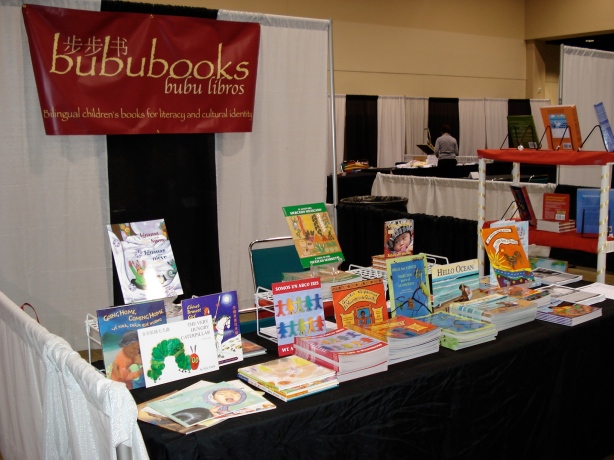 Research has shown that bilingual babies learn two languages at the same pace as monolingual babies learn one language, even though they’re learning twice as much. Even better, two researchers recently learned in their scientific study that bilingual babies are ‘flexible learners’ and use their learning skills more efficiently. They pick up on skills faster and can apply them to other aspects in their learning. Read the article we’ve posted below by Jean Mercer, Ph.D. from Psychology Today to see her full explanation of the study and its findings.
Research has shown that bilingual babies learn two languages at the same pace as monolingual babies learn one language, even though they’re learning twice as much. Even better, two researchers recently learned in their scientific study that bilingual babies are ‘flexible learners’ and use their learning skills more efficiently. They pick up on skills faster and can apply them to other aspects in their learning. Read the article we’ve posted below by Jean Mercer, Ph.D. from Psychology Today to see her full explanation of the study and its findings.
What great encouragement to raise your kids bilingually!!
Taken from: Child Myths
Straight Talk About Child Development
by Jean Mercer, Ph.D.
Jean Mercer is a developmental psychologist with a special interest in parent-infant relationships.
Bilingual Babies: Another Myth Busted
Surprise! Bilingual babies do better at learning.
In my last post, I commented on some preferences and behaviors that help babies pay attention to talking adults and learn about language from what they hear. Babies’ social interest in other people and their attentiveness to high-pitched, emphatic speech are factors that help them learn from baby talk. When adults talk to other adults, or when television or an audiotape provides speech experience, babies don’t learn as much as they do from baby talk.
What are some other relevant factors about babies’ experience with the spoken language? One situation of considerable interest is the experience of two or more different languages, whether spoken by the same person or by different people. Many of us would guess that life could be very confusing for bilingual babies and that they might be slowed down in their general language learning. At least, that’s what many people would guess in the United States, where a large proportion of the population is monolingual, and where language learning is generally regarded as difficult. Assumptions are probably different in the many parts of the world where most people are fluent from an early age in two, three, or more languages. Different groups treasure different myths, and the one about the language difficulties of bilingual babies is one that belongs primarily to monolingual English-speaking Americans.
A recent article by Agnes Kovacs and Jacques Mehler ( “Flexible learning of multiple speech structures in bilingual infants”, Science, 2009, Vol. 325, pp. 611-612) includes some surprising reports about bilingual 12-monh-olds. For starters, Kovacs and Mehler point out previous research showing that bilingual children achieve language developmental milestones at about the same age as learners of a single language, even though that means they have to learn about twice as much. Whether they are learning one language or two, babies say their first words at an average of about 12 months ( although there are many individual differences in this, and that average is made up of babies whose first word comes anywhere from 9 months to perhaps 18 months).
Can it be that bilingual babies learn more than just language from their bilingual experiences? Kovacs and Mehler were interested in this question and wondered whether the bilingual children’s experience might help them become more efficient in understanding and using information from speech. The researchers set up a situation in which 12-month-olds could learn that the structure of a “nonsense word” would tell them whether an interesting toy was going to appear on the left or on the right. There were two kinds of nonsense words, each consisting of three syllables. For one kind, the first and the last syllables were the same, and the middle syllable was different for (instance, “lo-vu-lo”). For the other kind, the first two syllables were the same, and the last one was different (for instance, “lo-lo-vu”). The babies saw and heard the appearance of the toy and the sound pattern associated in a consistent way. “Lo-vu-lo” could mean that the toy would be on the left, and “lo-lo-vu” could mean that the toy would be on the right, for example. Kovacs and Mehler had a device that measured the babies’ eye movements and showed in which direction a baby was looking at a given time, so they could see whether each baby learned to look in the direction indicated by a particular sound pattern.
Now, here’s the myth-busting surprise: although all the babies learned that one pattern (such as “lo-lo-vu”) meant that the toy was in a particular place, only the bilingual babies learned both associations– that “lo-lo-vu” meant “look left”, and “lo-vu-lo” meant “look right.” In a further experiment, the monolingual babies could learn that a male voice saying the nonsense word meant to look one direction and a female voice meant to look the other direction, so they were capable of learning something about speech sounds and directions. But the monolingual babies did not manage to learn at this early age that different but similar sound patterns had different meanings.
Kovacs and Mehler concluded that the experience of bilingual life had made these babies “flexible learners” who could apply their very efficient learning skills to get a lot of information out of the speech sounds they heard, selecting the right response out of the two they had learned. Of course, choosing the right response is an essential part of much school performance. If you subtract even though you see a plus sign, or add even though you see a minus sign, you won’t get the right answer, no matter how many facts you know.
Watch for the first commercial application of this research– but don’t buy it unless there’s good evidence that it helps facilitate flexible learning outside the laboratory!
Thanks for reading. By the way, October 3, 2009, was the Mid-Autumn holiday in China and many other countries. We hope you enjoyed the festivities!








